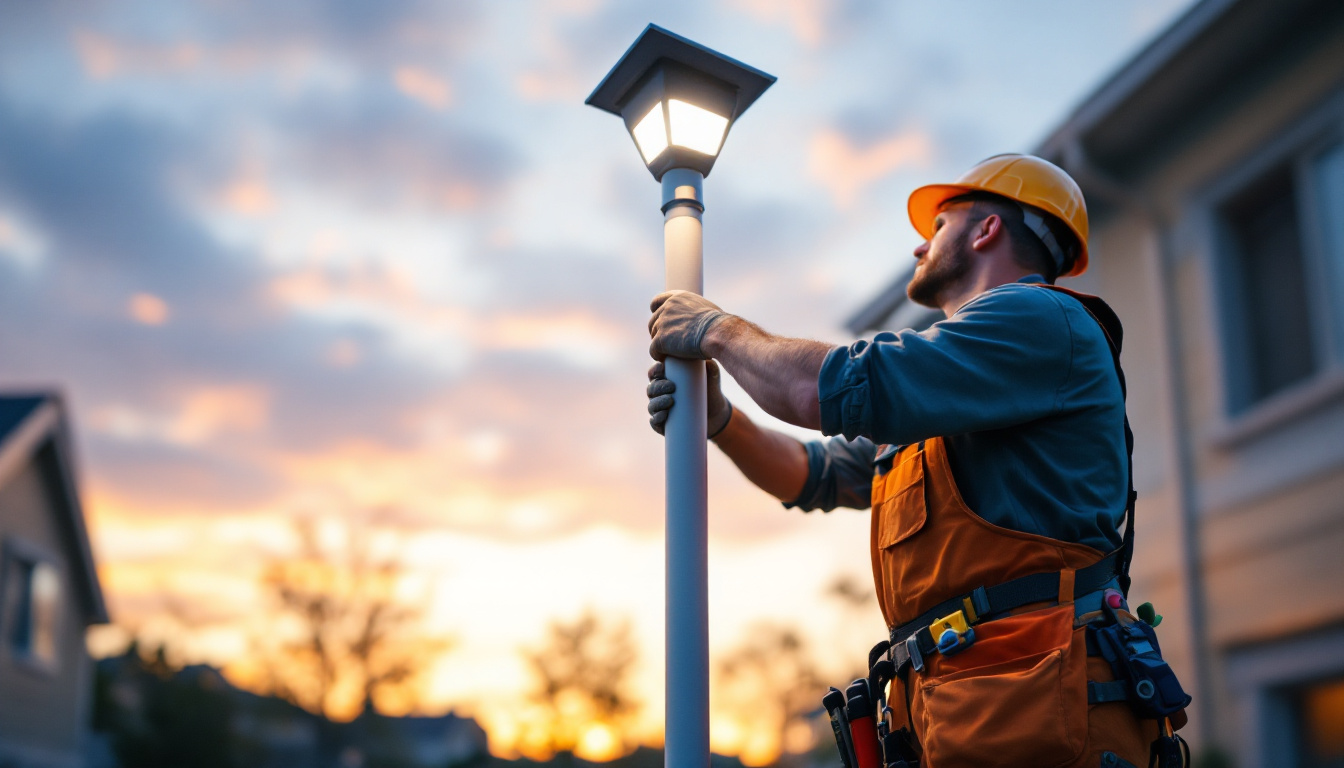
As the demand for sustainable energy solutions continues to rise, solar light posts have become an increasingly popular choice for both residential and commercial applications. However, lighting contractors often encounter a series of common mistakes when working with solar lighting systems. Understanding these pitfalls can not only enhance project outcomes but also improve client satisfaction. This article delves into the frequent missteps made by contractors in the solar light post installation process and offers insights on how to avoid them.
One of the most significant errors that lighting contractors make is a lack of understanding of how solar technology functions. Solar light posts rely on photovoltaic cells to convert sunlight into electricity, which powers the LED lights. If contractors do not fully grasp this process, they may miscalculate the energy needs of the project.
For instance, failing to consider the location’s solar exposure can lead to inadequate lighting performance. Inadequate sunlight can result in insufficient charging of the batteries, causing the lights to dim or fail to operate altogether. Contractors should invest time in learning about solar energy fundamentals to ensure they can make informed decisions regarding product selection and installation.
Moreover, understanding the efficiency ratings of different solar panels is crucial. Not all photovoltaic cells are created equal; some may perform better in low-light conditions, while others are optimized for maximum sunlight exposure. By familiarizing themselves with the various types of solar technology available, contractors can select the most suitable products that align with the specific requirements of their projects. This knowledge not only enhances the performance of the solar lights but also contributes to the longevity and reliability of the installation.
Another common oversight is the failure to conduct thorough site assessments. Each installation site presents unique challenges, such as varying degrees of shade, obstructions, and geographical features that can affect solar performance. Without a comprehensive site analysis, contractors may choose inappropriate locations for the solar light posts, leading to diminished functionality.
To mitigate this risk, contractors should perform detailed assessments that take into account the sun’s path, potential obstructions, and seasonal variations in sunlight. This information is crucial for determining the optimal placement of solar light posts to maximize their efficiency. Additionally, contractors should consider the local climate and weather patterns, as these factors can also influence the performance of solar technology. For example, areas with frequent cloud cover or heavy rainfall may require more robust solar solutions or backup systems to ensure consistent lighting. By taking these elements into account, contractors can enhance the reliability of their installations and provide clients with a more effective lighting solution.
Contractors sometimes make the mistake of selecting solar light posts based solely on aesthetics or initial cost, rather than considering the long-term performance and reliability of the products. Not all solar lights are created equal; they vary significantly in terms of quality, brightness, battery capacity, and durability. For instance, some solar lights may look appealing but utilize inferior materials that can degrade quickly under harsh weather conditions, leading to a diminished lifespan and performance.
Investing in low-quality products may lead to frequent replacements and repairs, ultimately costing more in the long run. It is essential for contractors to research and choose reputable brands that offer reliable warranties and customer support. This diligence can save time and money while ensuring client satisfaction. Additionally, reading customer reviews and seeking recommendations from industry professionals can provide valuable insights into the performance of specific products, helping contractors make informed decisions that align with their project goals.
Another critical mistake is neglecting to calculate the energy needs of the lighting system accurately. Contractors must consider the total wattage required for the project, the number of hours the lights will be in use, and the battery capacity necessary to sustain operation during periods of low sunlight. This requires a thorough understanding of the environmental conditions in which the lights will operate, as factors such as geographical location and seasonal variations can significantly impact solar energy generation.
Failure to perform these calculations can result in underpowered systems that do not meet the client’s expectations. By taking the time to assess energy requirements, contractors can design a solar lighting system that operates effectively and efficiently, providing the desired illumination. Furthermore, integrating smart technology, such as motion sensors or timers, can enhance energy efficiency and extend the life of the solar lights, making them an even more attractive option for clients looking to reduce their energy consumption and carbon footprint.
Installation errors can significantly impact the performance and longevity of solar light posts. Common mistakes include incorrect mounting heights, poor alignment, and inadequate securing of components. These errors can lead to misdirected light, reduced efficiency, and even damage to the fixtures. For instance, if a solar light post is mounted too low, it may not effectively illuminate the intended area, while a post mounted too high may cause light to scatter, reducing its effectiveness.
Contractors should adhere to manufacturer guidelines and best practices during installation. This includes ensuring that solar panels are positioned to receive maximum sunlight and that light fixtures are securely mounted to withstand environmental conditions. Attention to detail during installation can prevent future issues and enhance the overall quality of the project. Additionally, using tools such as levelers and measuring tapes can help ensure that installations are precise, ultimately leading to better performance and aesthetics. Understanding the specific environmental factors of the installation site, such as shade from nearby trees or buildings, can also play a crucial role in achieving optimal results.
Many contractors overlook the importance of battery maintenance in solar lighting systems. Batteries are crucial for storing energy generated during the day and powering the lights at night. If contractors fail to educate clients on proper battery care, it can lead to premature battery failure and diminished lighting performance. For example, neglecting to clean the battery terminals can result in corrosion, which inhibits the battery’s ability to charge effectively.
Contractors should provide clients with clear instructions on how to maintain their solar light systems, including periodic checks of battery health and replacement schedules. This proactive approach can extend the lifespan of the lighting system and ensure consistent performance. Furthermore, educating clients about the signs of battery wear, such as dimming lights or flickering, can empower them to take timely action. Offering a maintenance service or follow-up consultations can also enhance client satisfaction and foster long-term relationships, ensuring that the solar lighting systems remain functional and efficient for years to come.
Effective communication with clients is paramount in any project, especially when it comes to solar lighting systems. Contractors often make the mistake of not setting realistic expectations regarding the performance and limitations of solar light posts. Clients may have misconceptions about how solar technology works, leading to disappointment when the lights do not perform as anticipated.
Contractors should take the time to educate clients about the capabilities of solar lighting, including factors that can affect performance, such as weather conditions and geographical location. By providing clear information, contractors can foster trust and ensure that clients have a realistic understanding of what to expect from their solar lighting systems.
After the installation of solar light posts, contractors may neglect to follow up with clients to gather feedback on the system’s performance. This oversight can lead to missed opportunities for improvement and potential repeat business. Engaging with clients after the project is completed can provide valuable insights into their satisfaction levels and any issues they may encounter.
Contractors should establish a follow-up process that includes checking in with clients several weeks after installation. This approach not only demonstrates a commitment to quality service but also allows contractors to address any concerns promptly and make necessary adjustments.
Lighting contractors must be aware of local regulations and guidelines regarding solar installations. Failing to comply with these regulations can result in fines, project delays, and potential legal issues. Each municipality may have different requirements for solar lighting, including zoning laws and safety standards.
Before beginning any project, contractors should familiarize themselves with local regulations and ensure that their installations meet all necessary criteria. This diligence can help avoid complications and ensure a smooth installation process.
While solar light posts are inherently more environmentally friendly than traditional lighting options, contractors should still consider the broader environmental impact of their installations. For example, the materials used in solar light posts can vary significantly in terms of sustainability.
Contractors should prioritize products made from recyclable materials and consider the overall lifecycle of the products they choose. By selecting environmentally responsible options, contractors can further enhance the sustainability of their projects and appeal to eco-conscious clients.
In conclusion, lighting contractors can avoid common mistakes associated with solar light post installations by prioritizing education, thorough planning, and effective communication. By understanding the technology, conducting site assessments, selecting quality products, and maintaining open lines of communication with clients, contractors can enhance project outcomes and ensure client satisfaction.
As the industry continues to evolve, staying informed about advancements in solar technology and best practices will be crucial for contractors looking to thrive in the competitive lighting market. By learning from past mistakes and continuously improving their approach, contractors can position themselves as trusted experts in solar lighting solutions.
Ready to elevate your solar light post installations and avoid common pitfalls? Choose LumenWholesale for your lighting needs and experience the difference quality makes. Our spec-grade lighting products are designed to meet the highest industry standards, ensuring you deliver reliable and high-performance lighting to your clients. With unbeatable wholesale prices and the convenience of free shipping on bulk orders, you can trust that you’re getting the best value without any hidden fees. Don’t compromise on quality or affordability. Discover wholesale lighting at the best value today and light up your projects with confidence.

Discover the essential compliance requirements for lighting contractors in the ever-evolving industry landscape.

Discover essential tips for installing Goldgooseneck sconces outdoors and learn how to sidestep common pitfalls in lighting projects.

Discover why purchasing light bulbs and LED tubes in bulk from local distributors might not be the best choice.

Discover essential strategies to sidestep common pitfalls in lighting projects with our comprehensive guide on light manufacturing.